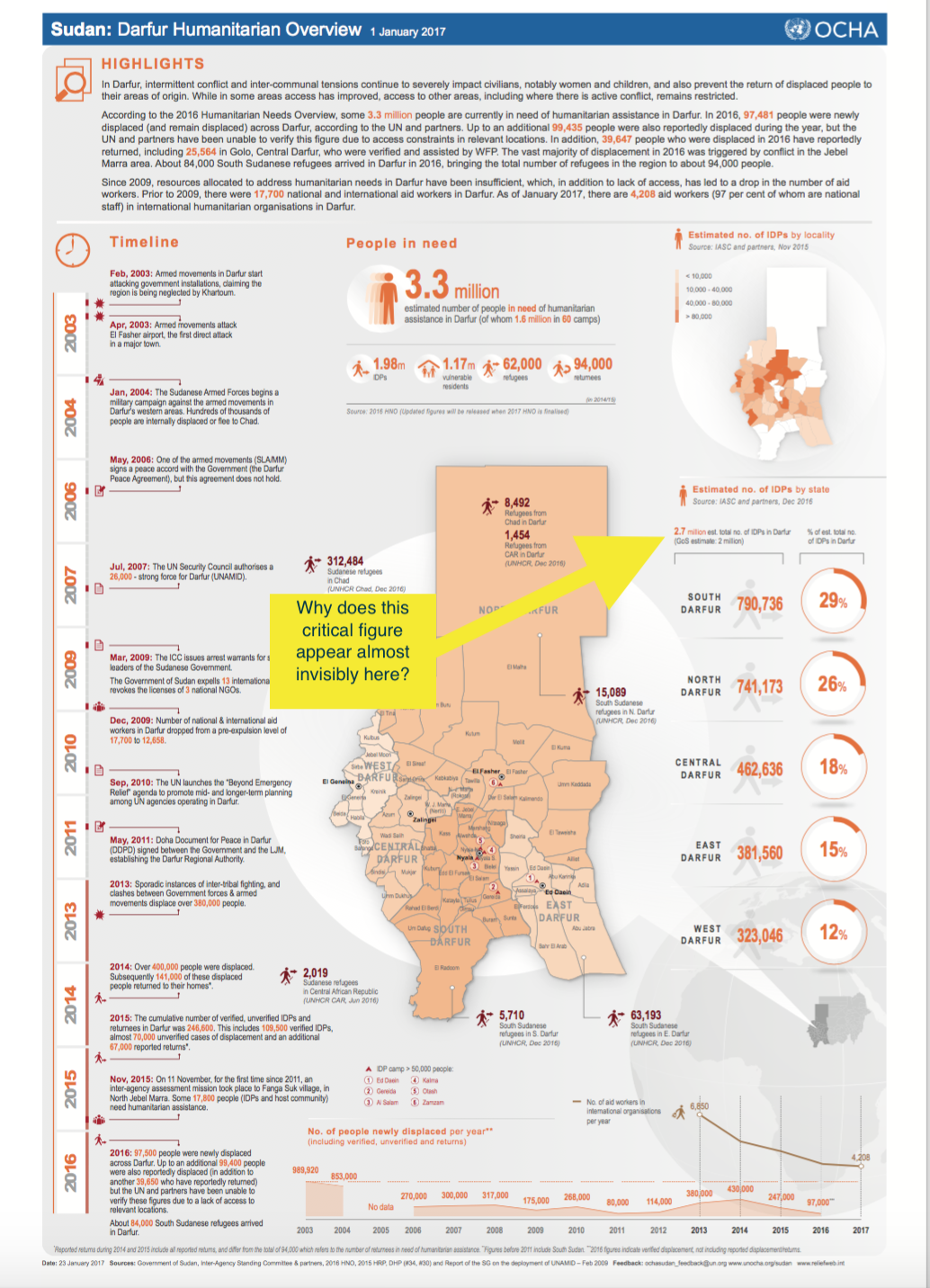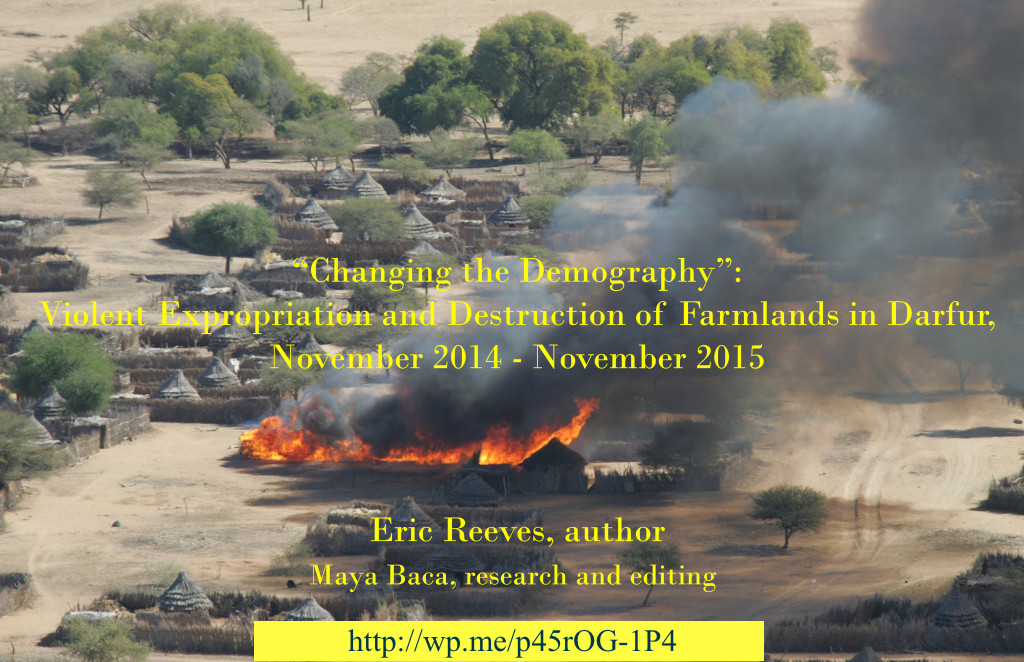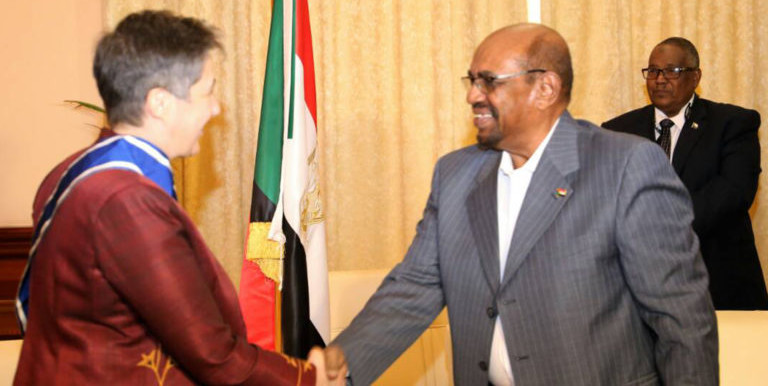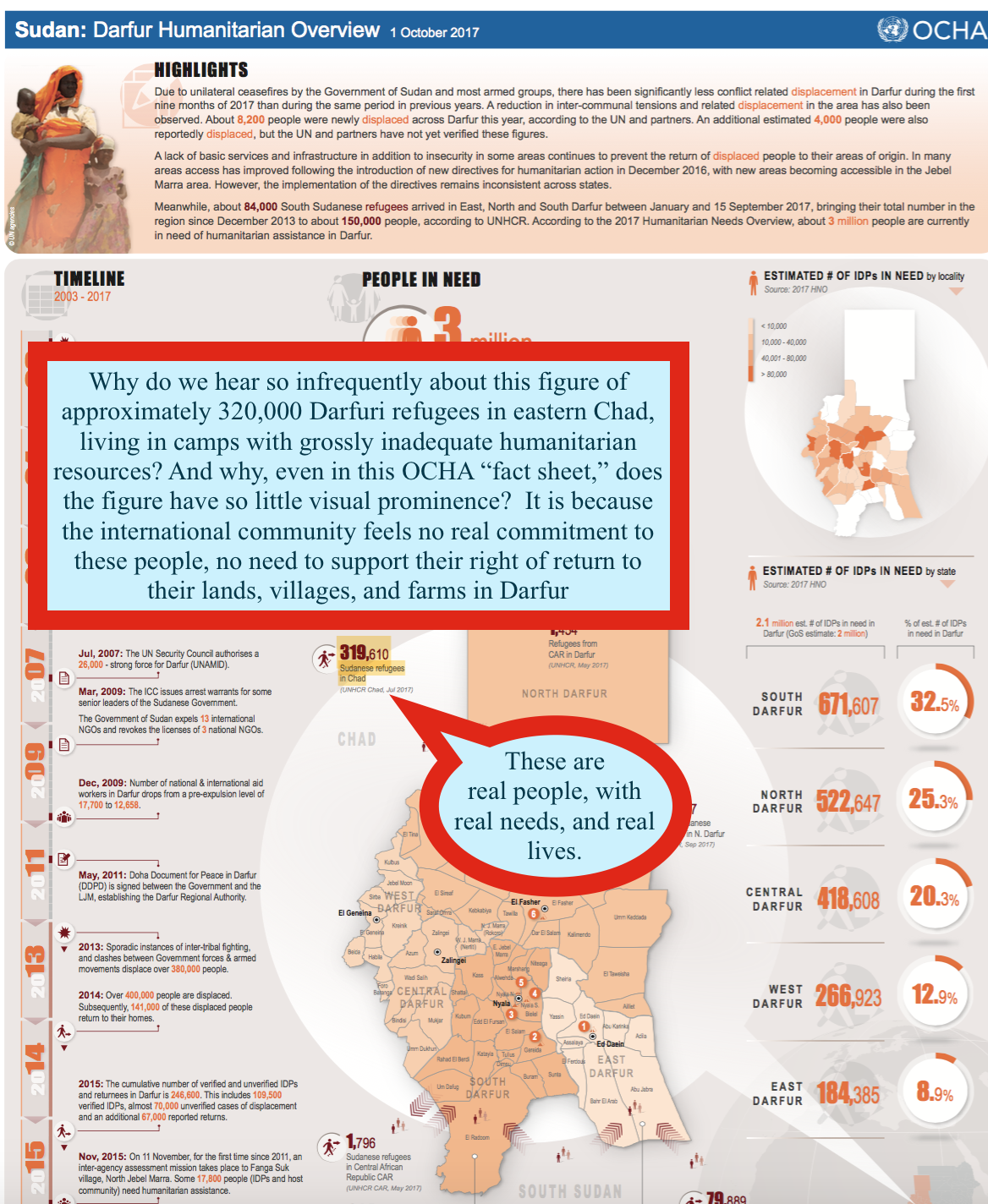The UN Solution to the Darfur Genocide? Lies…promulgate false or deeply distorted figures and characterizations
Eric Reeves | October 2018 | https://wp.me/p45rOG-2iO
The UN has decided that lies, outright mendacity, are the best response to ongoing ethnically-targeted violence in Darfur, massive displacement, and Khartoum regime that remains deeply hostile to an international humanitarian presence. This takes the form of echoing Khartoum’s various pronouncements on the security situation and the number of internally displaced persons. The recent preposterous comments by UN Resident and Humanitarian Coordinator for Sudan, Gwi-Yeop Son continue those of previous UN Resident and Humanitarian Coordinator in Sudan, Marta Ruedas.
Former UN Resident and Humanitarian Coordinator for Sudan Marta Reudas is revealingly seen here being awarded the First-Class Order of the Two Niles by ICC-indicted génocidaire Omar Al Bashir; there could hardly be a more despicable action by a senior UN official.
Current UN Resident and Humanitarian Coordinator for Sudan, Gwi-Yeop Son, recently declared that there has been “significant” improvement in security in Darfur, echoing the comments of North Darfur governor Mohamed Beraima Hassab al-Nabi: “lawlessness situation has come to an end…the security situation in North Darfur is calm and stable” (Sudan Tribune, September 4, 2018 | http://www.sudantribune.com/spip.php?article66178/). This is patently false and belied by Radio Dabanga reports from the ground over the past year and more. I have assembled an Appendix comprising a bibliography of reports and compendia of reports for 2018 and 2017 that makes all too clear that insecurity in Darfur is pervasive and the primary reason people are afraid to return to their homes and lands.
We also have a tremendous number of reports of people attempting to return to their villages, homes, and farms—only to be confronted by violence from armed Arab groups that have seized their lands. Women and girls attempting to work their farms from nearby IDP camps are frequently raped and sexually assaulted; the epidemic of sexual violence shows no signs of ending. See |
“Continuing Mass Rape of Girls in Darfur: The most heinous crime generates no international outrage,” January 2016 | Eric Reeves, author | Maya Baca, research and editing | http://sudanreeves.org/2017/10/15/continuing-mass-rape-of-girls-in-darfur-the-most-heinous-crime-generates-no-international-outrage-january-2016/
[Arabic translation of this report | http://wp.me/p45rOG-1Rr ]
[Arabic names for key locations on maps | http://wp.me/p45rOG-1Si ]
This outrageous misrepresentation of the security situation in Darfur has evidently emboldened Gwi-Yeop Son to indulge an even more significant misrepresentation, reported today by Radio Dabanga:
“The year 2018 has seen only about 25,000 people displaced, meaning that the number of displaced has decreased by 92 per cent.” She explained that the number of returnees to their villages has increased reaching more than 300,000 this year. (UN: Fewer people displaced in Sudan in 2018 | Radio Dabanga, October 8, 2018 | KHARTOUM)
No evidence is given for this preposterous figure of “more than 300,000” people returning to their villages—because there is none. Nor does the figure of “only about 25,000 people” newly displaced in 2018 comport with July 2018 reports from the Jebel Marra region indicating that fighting displaced between 50,000 and 80,000 people in this part of Darfur alone. But because the UN has decided over the past year to accept Khartoum’s radically low figure for the number of Internally Displaced Persons (IDPs), this requires massive, if utterly factitious, numbers for those who must have “returned to their villages.” A look at the UN’s own figures shows that this is the only explanation.
In 2017 the UN Office for the Coordination of Humanitarian Affairs (UN OCHA) promulgated, if rather inconspicuously, a figure of 2.7 million Internally Displaced Persons (IDPs) in Darfur. Parenthetically it noted that the Khartoum regime was using a figure of 2 million IPDs—700,000 fewer IDPs. See the graphic below:
But by the middle of 2018, UN OCHA was itself using only Khartoum’s figure, with no indication of how their own data justified a reduction of 700,000 in the number of IDPs: “[there are] some two million internally displaced persons (IDPs) [in Darfur].” (UN OCHA | Humanitarian Bulletin Sudan Issue 11 | 28 May 2018 – 10 June 2018 |https://reliefweb.int/sites/reliefweb.int/files/resources/OCHA_Sudan_Humanitarian_Bulletin_Issue_11_%2828_May_-_10_June_2018%29.pdf /)
No explanation was offered—the number of IDPs was simply reduced because of Khartoum’s demands, not because any data justified such reduction. This is all that lies behind Gwi-Yeop Son’s claim that “the number of returnees to their villages has increased reaching more than 300,000 this year.” Indeed, one surmises that she uses this figure of 300,000 rather returns than the 700,000 implied by UN OCHA’s reducing the number of IDPs only because it is slightly less preposterous. But preposterous it is: returning IDPs on a scale this large would have been widely reported by those on the ground, typically via Radio Dabanga; there has been no such reporting, or anything remotely suggesting the credibility of the figure “300,000.”
There simply is no evidence of this number of returns, nothing in the dispatches of human rights organization, Radio Dabanga (with a vast reporting presence on the ground in Darfur), Sudan Tribune, or reports from humanitarian organizations, or accounts from my many contacts in the Darfuri diaspora. Such a vast number of returns would certainly have been reported if it had occurred, if only because of the massive restorations of land that would have been required for people to return to their lands. Yet such land restoration remains the primary obstacle to anything like a just peace in Darfur, even if the UN and other international actors refuse to acknowledge as much. See |
Darfuri Refugees in Eastern Chad
The UN has been equally unwilling to highlight the fact that there are more than 300,000 Darfuri refugees in eastern Chad, although when figures are promulgated they should remind us that they are essentially unchanged because there have been so very few returns—numbering not even in the thousands. And we may be sure that Darfuri IDPs and Darfuri refugees are comparable as populations, certainly with respect to a willingness to return to their homes and villages amidst the present massive insecurity—an insecurity shamelessly denied for many reasons, but chiefly because it is the line that Khartoum demands be taken. The precision of the figure in the graphic below—319,610 Darfuri refugees—makes clear that the total is a census from the twelve refugee camps near the Chad/Darfur border, and may very well exclude significant numbers of people not in the camps.
UNHCR is more casual now in its reporting, declaring only that “some 300,000 refugees from Darfur are currently living in 12 UNHCR and government run camps in eastern Chad” (April 20, 2018 UNHCR News Brief | http://www.unhcr.org/en-us/news/briefing/2018/4/5ad9a4604/first-darfur-refugee-returns-from-chad.html ).We may well wonder where the 19,610 reported in 2017 have disappeared to, or whether this is UNHCR’s way of “rounding down” figures that are embarrassing to the High Commission. This is particularly dismaying, given UNHCR’s celebration of even exceedingly small numbers of returns in its news dispatches, as if this were somehow representative of a larger trend when clearly it is not:
A group of 53 refugees left the Iridimi camp in eastern Chad last Saturday and arrived in a reception centre in Tina, North Darfur after a road journey of four hours (70 kilometers) in UNHCR arranged buses. On arrival in Sudan, they spent two days in a reception centre before heading on to their final destinations. These returnees are the first of thousands who are expected to return voluntarily in the coming months. Most have been living in Chad for years.
There is no large-scale return of refugees, nor have anything like “more than 300,000” displaced persons returning to their villages this year, as UN Resident and Humanitarian Coordinator for Sudan, as Gwi-Yeop Son would have it.
Insecurity Remains at Intolerable Levels
The radical drawdown of the UN/African Union Mission in Darfur, to the extent it provided marginal security, has had a negative effect on security in the region; its complete withdrawal by 2020 ensures that the only source of force exerting control in the region will be the Sudan Armed Forces and the brutal militia force known as the Rapid Support Forces, which has been instrumental in much of the human displacement and ethnically-targeted destruction over the past five years. The UN Department of Peacekeeping Operations has tried to paint a happy face on the withdrawal of UNAMID, but the truth is that it will almost certainly be recorded as the greatest failure in UN peacekeeping history, despite its staggering cost (see Appendix).
Reports of violence, particularly ethnically-targeted violence, continue and make clear the impossibility of returns on the scale Gwi-Yeop Son mendaciously claims. So numerous are the reports of violence, so consistent in nature, and so relentless over months and years, that I can only gesture toward what the UN in its various agencies, offices, and departments works to deny. A perusal of the following bibliography should make clear to anyone not tasked with being an apologist for the UN or completely intimidated by the Khartoum regime that the world body is presenting to the international community a terribly distorted view of Darfur’s realities.
APPENDIX in three parts:
[A] The character of recent violence
[B] The consequences of violence
[C] The response of the UN to Darfur’s violence and suffering
[A] The character of recent violence
[1] “Continuing Mass Rape of Girls in Darfur: The most heinous crime generates no international outrage,” January 2016, Eric Reeves, author; Maya Baca, research and editing http://sudanreeves.org/2017/10/15/continuing-mass-rape-of-girls-in-darfur-the-most-heinous-crime-generates-no-international-outrage-january-2016/
[Arabic translation of this report | http://wp.me/p45rOG-1Rr ]
[Arabic names for key locations on maps | http://wp.me/p45rOG-1Si ]
[2]“‘Changing the Demography’: Violent Expropriation and Destruction of Farmlands in Darfur, November 2014 – November 2015,” December 1, 2015, Eric Reeves, author; Maya Baca, research and editing | http://sudanreeves.org/2017/10/15/changing-the-demography-violent-expropriation-and-destruction-of-farmlands-in-darfur-november-2014-november-2015/
[3] “Tales of slavery and torture for Darfuri refugees in Chad who have nowhere to go” Radio France International, August 8, 2018 | http://en.rfi.fr/africa/20180721-Tales-slavery-torture-Darfuri-refugees-Chad-who-have-nowhere-go
[4] “Darfur Refugees in Eastern Chad: The Most Invisible Casualties of the Darfur Genocide,” August 8, 2017,” Eric Reeves | http://sudanreeves.org/2017/08/08/darfur-refugees-in-eastern-chad-the-most-invisible-casualties-of-the-darfur-genocide/
[5] “Invisible, Forgotten, and Suffering: Darfuri Refugees in Eastern Chad,” Sudan Tribune | April 28, 2016,Eric Reeves | http://www.sudantribune.com/spip.php?article58797
[6] “Genocide Without End: Ethnically-targeted Violence in Darfur Continues,” March 26, 2018, Eric Reeves | http://sudanreeves.org/2018/03/26/genocide-without-end-ethnically-targeted-violence-in-darfur-continues/
[7] “Unrelenting Violence in Darfur: Recent Reporting by Radio Dabanga,” January 11, 2018, Eric Reeves | http://sudanreeves.org/2018/01/11/8415/
[8] “Violence, Insecurity, and Human Trafficking in Darfur: The International Community is Committed to a Profoundly False Narrative,” September 19, 2018, Eric Reeves | http://sudanreeves.org/2018/09/19/violence-insecurity-and-human-trafficking-in-darfur-the-international-community-is-committed-to-a-profoundly-false-narrative/
[9] “A Compendium of Recent Brief Commentaries/News Dispatches on Violence in | June 16 – June 30, 2018, Eric Reeves | http://sudanreeves.org/2018/06/30/a-compendium-of-recent-brief-commentaries-on-violence-in-darfur/
[10] “A Compendium of Recent Brief Commentaries/News Dispatches on Violence, Security Threats in Darfur” (Number 2), July 1 – July 24, 2018, Eric Reeves | http://sudanreeves.org/2018/07/24/a-compendium-of-recent-brief-commentaries-news-dispatches-on-violence-security-threats-in-darfur-number-2/
[11] “A Compendium of Recent Brief Commentaries/News Dispatches on Violence, Security Threats in Darfur” (Number 3), July 25, 2018 – August 11, 2018, Eric Reeves | http://sudanreeves.org/2018/08/15/a-compendium-of-recent-brief-commentaries-news-dispatches-on-violence-security-threats-in-darfur-number-3/
[12] “Dangers to Darfuris Attempting to Return to Their Villages and Lands Increase with Collapse of UNAMID,” June 28, 2018, Eric Reeves | http://sudanreeves.org/2018/06/28/dangers-to-darfuris-attempting-to-return-to-their-villages-and-lands-increase-with-collapse-of-unamid/
[13] “Jebel Marra: Ethnically-Targeted Human Destruction Again Accelerates in Darfur,” April 6, 2018, Eric Reeves | http://sudanreeves.org/2018/04/06/ethnically-targeted-human-destruction-again-accelerates-in-darfur/
[14] “Glimpses of Continuing Slow-Motion Genocide in Darfur: Recent Reports of Ethnically-Targeted Violence,” May 30, 2018, Eric Reeves | http://sudanreeves.org/2018/05/30/glimpses-of-continuing-slow-motion-genocide-in-darfur-recent-reports-of-ethnically-targeted-violence/
[15] “Recent Violence in Darfur Shows Just How Insecure the Region Remains,” April 12, 2018, Eric Reeves | http://sudanreeves.org/2018/04/12/8591/
[16] “Darfur’s Displaced Persons and the Question of Returns: A Catastrophe is Impending,” April 25, 2018, Eric Reeves | http://sudanreeves.org/2018/04/25/darfurs-displaced-persons-and-the-question-of-returns-a-catastrophe-is-impending/
[17] “A Grim Update to “Darfur’s Displaced Persons and the Question of Returns,” April 27, 2018), Eric Reeves | http://sudanreeves.org/2018/04/27/a-grim-update-to-darfurs-displaced-persons-and-the-question-of-returns-a-catastrophe-is-impending/
[18] “Assaults on Camps for the Displaced in Darfur: History Makes Clear They Will Increase,” August 27, 2017, Eric Reeves | http://sudanreeves.org/2017/08/27/assaults-on-camps-for-the-displaced-in-darfur-history-makes-clear-the-will-increase/
[19] “Internally Displaced Persons in Darfur: The invisible catastrophe, international complicity,” March 19, 2017, Eric Reeves | http://sudanreeves.org/2017/03/19/internally-displaced-persons-in-darfur-the-invisible-catastrophe/
B. The consequences of violence
[1] “Now Ten Years Since the UN Offered a Mortality Estimate for the Darfur Genocide,” April 22, 2018, Eric Reeves | http://sudanreeves.org/2018/04/22/now-ten-years-since-the-un-offered-a-morality-estimate-for-the-darfur-genocide/
[Aggregated data and reports strongly suggest a total mortality figure of approximately 600,000 dead from the direct or indirect effects of violence in Darfur and eastern Chad since early 2003—ER]
[2] “Almost 4,000,000 Sudanese displaced by fighting,” Al Jazeera, June 1, 2017 http://www.aljazeera.com/news/2017/06/4000000-sudanese-displaced-fighting-170601165141799.html
Norwegian Refugee Council ranks country as number three in world’s neglected crises as fighting [in Darfur] enters its 14th year.
[Actually, the conflict is entering its 15th year; its beginning is typically dated to February 2003—already over 14 years ago. But the total figure rendered by NPA calls further into question UN figures for displacement (see above)—ER]
Almost 4,000,000 Sudanese have been forced from their homes in 14 years of tribal violence and battles between government and opposition fighters, the Norwegian Refugee Council says.
[This is a badly misleading summary explanation of displacement in Darfur: the vast majority of the “fighting” has been violence directed against the non-Arab/African civilian tribal populations of Darfur, by Khartoum’s military (the Sudan Armed Forces/SAF) and its Arab militia allies—ER]
[3] “Darfur displaced: ‘We cannot return as long as our land is occupied’” | Radio Dabanga, April 9, 2018 | KALMA CAMP:
Last week, the residents of Kalma camp in Nyala, the capital of South Darfur, briefed a US government delegation about the situation of the displaced in the region and the reasons why they still cannot return to their areas of origin. “The American delegation met with the camp administration in the presence of the deputy director of UNAMID in South Darfur,” Yagoub Abdallah, the general coordinator of the Darfur Displaced and Refugees Association told Radio Dabanga.
“The US representatives inquired about the voluntary repatriation programme, whether people had returned already, and as well about the reasons preventing the displaced from returning to their villages,” he reported.
The displaced told the delegation that only a small number of people returned to their areas last year and early this year. “But they soon returned to the camp because of the aggression they met from militiamen and new settlers.” “We explained the American visitors that apart from the insecurity still caused by the many militiamen in the region, the presence of new, armed settlers is preventing the displaced to return to their villages.
“The new settlers, consisting of Arab herders from Darfur or migrants from Chad or Niger, are occupying our lands with the support of the authorities,” the camp leader said. “These settlers assault anyone who tries to return to their village.
The displaced further told the American delegation that the government is still continuing its war against the Darfuris. “Government militiamen are now burning villages in Jebel Marra.” The camp leaders handed the US representatives a memorandum in which they had listed their concerns. They called on the USA and the international community to provide protection to the displaced people in Darfur, to pressure the Sudanese government to stop distributing land to investors and new settlers, and to press for the arrest of all of those indicted by the International Criminal Court.
Returns in Darfur are rare because they are extraordinarily dangerous, which is why displaced persons represent almost half the population of the region: 2.7 internally displaced persons (overwhelmingly non-Arab/African) and more than 300,000 Darfuri refugees in eastern Chad (again, overwhelmingly non-Arab/African). These figures have not changed significantly in recent years because insecurity is intolerable, and returns—even to work lands near to IDP camps—have typically been met with violence, often brutal in nature
[C] The response of the UN to Darfur’s violence and suffering
[1]“The Failure of the UN/African Union Mission in Darfur: A Summary of Recent Assessments,” May 16, 2018, Eric Reeves | http://sudanreeves.org/2018/05/16/the-failure-of-the-un-african-union-mission-in-darfur-recent-assessments/
[2] “Displacement in Sudan and Darfur: UN figures continue to be careless, corrupt, or inadequate,” May 22, 2017, Eric Reeves | http://sudanreeves.org/2017/05/22/displacement-in-sudan-and-darfur-un-figures-continue-to-be-careless-or-inadequate/
[3] “Report on UNAMID in Darfur by Secretary-General António Guterres: More Misrepresentations than Truth,” March 9, 2018, Eric Reeves | http://sudanreeves.org/2018/03/09/report-on-unamid-in-darfur-by-secretary-general-antonio-guterres-more-misrepresentations-than-truth/
[4] “UN and African Union Complicity in Obscuring Darfur’s Realities: A long and disgraceful pattern of behavior,” February 21, 2018, Eric Reeves | http://sudanreeves.org/2018/02/22/un-and-african-union-complicity-in-obscuring-darfurs-realities-a-long-and-disgraceful-pattern-of-behavior/
[5] UNHCR: Global Trends FORCED DISPLACEMENT IN 2017 | http://www.unhcr.org/5b27be547.pdf
[Astonishingly, there is not a single specific mention of Darfur in this report—ER]

